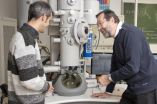(Press-News.org) The majority of patients on the liver transplant waitlist who died received offers of high-quality donated livers that were declined prior to their death, according to a new study in Gastroenterology, the official journal of the American Gastroenterological Association. Therefore, efforts other than simply increasing the availability of donated livers or the number of offers are needed to substantially reduce the deaths among those waiting for a transplant.
"Our findings suggest that waitlist deaths are not simply due to lack of donor organs, as many of us assume. Rather, deaths result from opportunities for transplantation that were declined," said John P. Roberts, MD, of the University of California San Francisco and lead author of this study. "Efforts should also be made to reduce the stigma associated with non-ideal livers and set realistic expectations for waitlisted candidates."
Researchers analyzed data from the United Network for Organ Sharing (UNOS) registry on all U.S. liver transplantation candidates who were offered livers from Feb. 1, 2005, to Jan. 31, 2010. Candidates were excluded if their Model for End-Stage Liver Disease (MELD) score — which is used to prioritize the urgency for liver transplant — was less than 15. Of 33,389 candidates for liver transplantation, researchers found that 20 percent died or were removed from the list, and 64 percent received a transplant. Among the subgroup of 6,787 transplant candidates who eventually died or were removed from the waitlist for being too sick, 84 percent had received at least one organ offer. More surprisingly, these candidates received not just one or two, but a median of six liver offers during their time on the waitlist.
"Donor quality/age" was cited as the most common reason for why transplant centers refused the organ. However, when organs considered "high quality" were analyzed, researchers found that 55 percent of transplant candidates who died or were removed from the waitlist before being transplanted had been offered at least one of these high-quality organs. This suggests that data from the UNOS/Organ Procurement Transplantation Network does not accurately or fully capture the true reason why these organs are refused. Understanding the real-time factors involved in these decisions is vital to improving the waitlist process for liver transplant candidates.
In a related editorial, Michael L. Volk, MD, MSc, and Carl L. Berg, MD, state that this study highlights the need to better inform patients about organ offers and to engage them in deciding whether to accept or decline such offers, rather than leaving this decision solely up to their physicians. Although it is assumed that most of these decisions are made with the best intent, it would be of interest to learn of patients' opinions about multiple organs being declined on their behalf.
Patients waiting for a liver transplant are prioritized by their risk of waitlist mortality, which is determined by their MELD score. Once a liver transplant becomes available, it is offered to the candidate who is first on the waitlist. Depending upon the quality of the donor liver relative to the perceived need of the candidate, this liver offer may be accepted for transplantation. However, the center to which the liver was offered can decline the organ, in which case, it will be offered to the candidate who is next on the waitlist, and similarly down the waitlist, until it is finally accepted for transplantation.
###
About the AGA Institute
The American Gastroenterological Association is the trusted voice of the GI community. Founded in 1897, the AGA has grown to include 17,000 members from around the globe who are involved in all aspects of the science, practice and advancement of gastroenterology. The AGA Institute administers the practice, research and educational programs of the organization. www.gastro.org.
About Gastroenterology
Gastroenterology, the official journal of the AGA Institute, is the most prominent scientific journal in the specialty and is in the top 1 percent of indexed medical journals internationally. The journal publishes clinical and basic science studies of all aspects of the digestive system, including the liver and pancreas, as well as nutrition. The journal is abstracted and indexed in Biological Abstracts, Current Awareness in Biological Sciences, Chemical Abstracts, Current Contents, Excerpta Medica, Index Medicus, Nutrition Abstracts and Science Citation Index. For more information, visit www.gastrojournal.org.
Like AGA, Gastroenterology and Clinical Gastroenterology and Hepatology on Facebook.
Join AGA on LinkedIn.
Follow us on Twitter @AmerGastroAssn.
Check out our videos on YouTube.
Many patients who die while awaiting liver transplant have had donor organs declined
2012-11-05
ELSE PRESS RELEASES FROM THIS DATE:
Women's body talk: Perception stronger than reality?
2012-11-05
How women think their friends feel about their bodies influences their own body concerns, according to a new study by Dr. Louise Wasylkiw and Molly Williamson from Mount Alison University in Canada. Their work, which examines the role of friends in young women's body concerns, is published online in Springer's journal Sex Roles.
Research shows that friends influence how girls and women view and judge their own body weight, shape and size. What Wasylkiw and Williamson's work sheds light on, is how much of a young woman's body concerns are shaped by her perceptions of ...
Build your own home theater for full-blast entertainment with 'Virtual Sound Ball'
2012-11-05
Daejeon, Republic of Korea, November 5th, 2012—Watching a 3 dimensional (3D) film at home can be just as real and fun as going to a movie theater. Professor Yang-Hann Kim and Research Professor Jung-Woo Choi from the Department of Mechanical Engineering, KAIST, have succeeded in building an audio rendering system that will considerably improve the current 3D audio effects technology.
3D audio effects can be produced by stereo speakers, surround-sound speakers, speaker-arrays, or headphones, which essentially give an illusion to listeners that sounds are being produced ...
Sensors for the real world
2012-11-05
Over the last decade there has been an increased interest in developing resonators for gravitmetric sensing; however, the sensors' response to variations in temperature has prevented them from being used outside the laboratory. New sensors developed by researchers at the University of Cambridge negate the effects of temperature so that they may be used in industries including health care, telecommunications and environmental monitoring.
Sensors built from high frequency bulk acoustic wave (BAW) resonators consist of a piezoelectric layer sandwiched between two electrodes, ...
Electron microscopes with a twist
2012-11-05
This press release is available in German.
Nowadays, electron microscopes are an essential tool, especially in the field of materials science. At TU Vienna, electron beams are being created that possess an inner rotation, similarly to a tornado. These "vortex beams" cannot only be used to display objects, but to investigate material-specific properties - with precision on a nanometer scale. A new breakthrough in research now allows scientists to produce much more intense vortex beams than ever before.
Quantum Tornado: the Electron as a Wave
In a tornado, the individual ...
High-strength material advancements at Wayne State University may lead to new, life-saving steel
2012-11-05
DETROIT— There has been great advancements in the development of the high-strength steel and the need for additional enhancements continue to grow. Various industries have a need for structural components that are lighter and stronger, improve energy efficiencies, reduce emissions and pollution increase safety and cost less to produce, particularly in the automotive industry.
A group of researchers in Wayne State University's College of Engineering have been working to create advanced materials with high-yield strength, fracture toughness and ductility. Their efforts ...
Duke Medicine news -- Some heart patients may respond differently to anti-platelet drugs
2012-11-05
DURHAM, N.C. – The cause of heart attacks or strokes among some patients treated with anti-platelet drugs may be different than for patients who have undergone surgical procedures to restore blood flow, according to researchers at Duke Medicine.
The finding -- reported Nov. 4, 2012, at the American Heart Association's Scientific Sessions annual meeting and published in the Journal of the American Medical Association – provides new insights into a subset of heart patients with acute coronary syndromes (ACS) whose risk for cardiovascular events remained unchanged despite ...
Cockatoo 'can make its own tools'
2012-11-05
A cockatoo from a species not known to use tools in the wild has been observed spontaneously making and using tools for reaching food and other objects.
A Goffin's cockatoo called 'Figaro', that has been reared in captivity and lives near Vienna, used his powerful beak to cut long splinters out of wooden beams in its aviary, or twigs out of a branch, to reach and rake in objects out of its reach. Researchers from the Universities of Oxford and Vienna filmed Figaro making and using these tools.
How the bird discovered how to make and use tools is unclear but shows how ...
High fever and evidence of a virus? Caution, it still may be Kawasaki disease
2012-11-05
Clinicians should take caution when diagnosing a child who has a high fever and whose tests show evidence of adenovirus, and not assume the virus is responsible for Kawasaki-like symptoms. According to a new study from Nationwide Children's Hospital appearing in Clinical Infectious Diseases, adenovirus detection is not uncommon among children with Kawasaki disease.
Kawasaki disease is a rare but serious condition in children that involves inflammation of the blood vessels, specifically the heart vessels that supply the heart tissue or coronary arteries. It is the most ...
Scientists identify insect-repelling compounds in Jatropha
2012-11-05
This press release is available in Spanish.
A tip about a folk remedy plant used in India and Africa to ward off bugs has led to the discovery of insect-repelling compounds.
U.S. Department of Agriculture (USDA) scientists have identified components of Jatropha curcas seed oil that are responsible for mosquito repellency. Researchers at the Agricultural Research Service (ARS) Natural Products Utilization Research Unit (NPURU) in Oxford, Miss., often find effective plant-derived compounds to deter insects by gathering plants in the wild and investigating those used ...
Loser-pays-all rule in criminal cases could work for wealthy defendants
2012-11-05
CHAMPAIGN, Ill. — Adopting a loser-pays-all rule for criminal litigation would likely be feasible only if the rule applied to defendants who are wealthy, says a study from a University of Illinois law professor.
Nuno Garoupa, the H. Ross and Helen Workman Research Scholar in the College of Law, says a loser-pays-all rule could deter some crime when it's applied to either a corporation or an individual with deep pockets. But when defendants are not wealthy, such cost-shifting would be "wholly inappropriate," he says.
"On the defendant's side, the problem is that a significant ...


